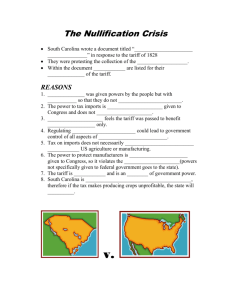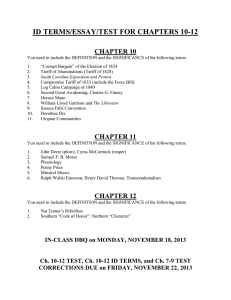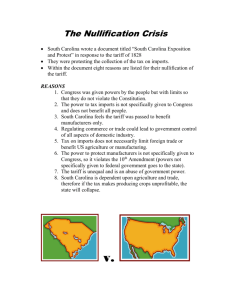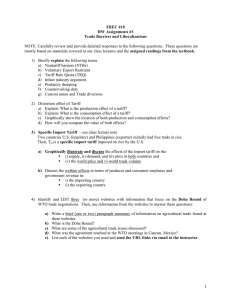14.581 International Trade — Lecture 26: Trade Policy Empirics (II) 14.581
advertisement
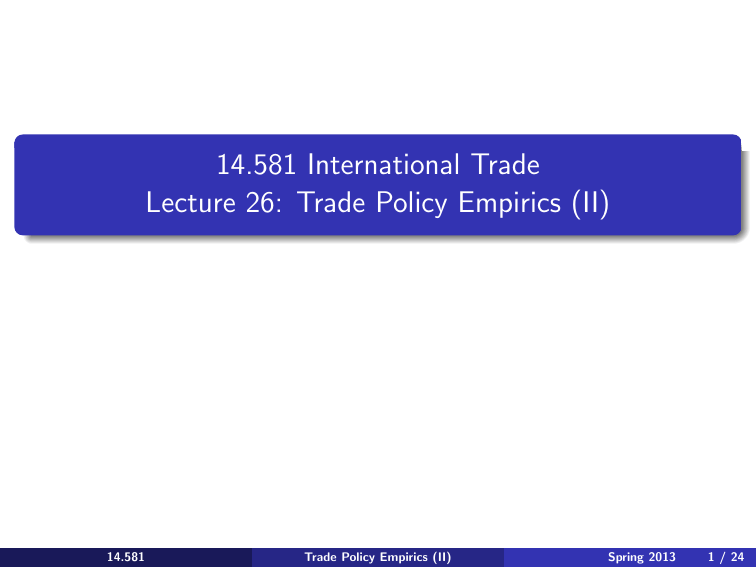
14.581 International Trade — Lecture 26: Trade Policy Empirics (II) — 14.581 Spring 2013 14.581 Trade Policy Empirics (II) Spring 2013 1 / 24 Plan for 2 lectures on empirics of trade policy 1 Explaining trade policy in isolation. Emphasis here is on non-benevolent governments (i.e. political economy of trade policy): Why even a SOE might choose trade protection. “First Generation”: Baldwin (1985) and Trefler (1993) “Second Generation”: Goldberg and Maggi (1999) 2 Explaining trade policy with international interactions. Emphasis here is on economies that are not small, and hence have an incentive to use trade policy to manipulate world prices. Trade agreements (GATT/WTO). Broda, Limao and Weinstein (2008); Bagwell and Staiger (2010) 14.581 Trade Policy Empirics (II) Spring 2013 2 / 24 Trade Agreements Given the strong and robust predictions made by theories of trade agreements (the GATT/WTO in particular) it is surprising how little empirical work there is on testing these theories. Recall that the key claim in a series of Bagwell and Staiger papers is that the key international externality that trade policies impose is the terms-of-trade externality, and further that the key principles of the GATT/WTO seem well designed to force member countries to internalize these externalities. 2 recent papers take nice steps towards filling this gap: 1 2 Broda, Limao and Weinstein (AER, 2008) Bagwell and Staiger (AER, 2010) 14.581 Trade Policy Empirics (II) Spring 2013 3 / 24 Broda, Limao and Weinstein (2008) With quasi-linear preferences across goods g , social welfare is given by (where π is producer surplus, ψ is consumer surplus and r is tariff revenue): W =1+ [πg (pg ) + rg (pg ) + ψg (pg )] (1) g Then (as in Johnson, 1954) the optimal tariff is given by the inverse (of the rest of the world’s) export supply elasticity: τgopt = ωg ≡ dpg∗ mg∗ dmg∗ pg∗ (2) In Grossman and Helpman (JPE 1995)—basically GH (1994) extended to a 2-country, strategically interacting, non-SOE world—the prediction is (where z is the inverse import penetration ratio and σ is the elasticity of import demand): Ig − α zg τgGH = ωg + (3) a + α σg 14.581 Trade Policy Empirics (II) Spring 2013 4 / 24 BLW (2008): Estimating ωg To test this, need estimates of ωg . Postulate the following system of constant elasticity import demand and export supply (of variety v in good g into country i in year t) where s is a share (and Δkig differences across both time and an ig pair): k ig Δkig ln sigvt = −(σig − 1)Δkig ln pivgt + εivgt Δkig ln pigvt = (4) ωig kig Δkig ln sivgt + δivgt 1 + ωig (5) BLW estimate this system through the same ‘identification through heteroskedasticity’ idea as Feenstra (AER, 1994) or Broda and kig kig Weinstein (QJE, 2006). Basic idea is that if E [εivgt δivgt ] = 0 and there is heteroskedasticity and there are more than 3 exporting countries, then can identify ωig and σig . 14.581 Trade Policy Empirics (II) Spring 2013 5 / 24 BLW (2008): Sample BLW then, having estimated ωig , estimate the relationship between tariffs and ωig . But for which countries? They do this on countries that (in certain time periods) were not part of the GATT/WTO and hence were presumably free to charge their unilaterally optimal tariff. 14.581 Trade Policy Empirics (II) Spring 2013 6 / 24 BLW (2008): Sample countries Table 1—Data Sources and Years GATT/WTO Algeria Belarus Bolivia c China Czech d Ecuador Latvia Lebanon Lithuania Oman Paraguay Russia Saudi Arabia Taiwan Ukraine Production data Accession date Source Years 8-Sep-1990 11-Dec-2001 15-Apr-1993 21-Jan-1996 10-Feb-1999 UNIDO UNIDO 93 93 UNIDO UNIDO 93 96 31-May-2001 9-Nov-2000 6-Jan-1994 UNIDO 97 UNIDO UNIDO 96 97 11-Dec-2005 1-Jan-2002 Tariff dataa Trade datab 93 97 93 93 92 93 97 00 97 92 91 94 91 96 97 93–03 98–03 93–03 93–03 93–03 94–03 94–03 97–02 94–03 94–03 94–03 96–03 93–03 92–96 96–02 a All tariff data are from TRAINS. Countries are included if we have tariff data for at least one year before accession (GATT/WTO). b Except for Taiwan, all trade data are from COMTRADE. For Taiwan, data are from TRAINS. c The date of the tariffs for Bolivia is post-GATT accession but those tariffs were set before GATT accession and unchanged between 1990–1993. d The Czech Republic entered the GATT as a sovereign country in 1993. Its tariffs in 1992 were common to Slovakia with which it had a federation, which was a GATT member. So it is possible that the tariffs for this country do not reflect a terms-of-trade motive. Our results by country in Table 9 support this. Moreover, as we note in Sec­tion IVC, the pooled tariff results are robust to dropping the Czech Republic. Courtesy of Christian Broda, Nuno Limao, David E. Weinstein, and the American Economic Association. Used with permission. 14.581 Trade Policy Empirics (II) Spring 2013 7 / 24 BLW (2008): Results The elasticity estimates ωig Table 3A—Inverse Export Supply Elasticity Statistics Statistic Observations Sample Algeria Belarus Bolivia China Czech Republic Ecuador Latvia Lebanon Lithuania Oman Paraguay Russia Saudi Arabia Taiwan Ukraine Median a Medianb Mean Standard deviation All Low Medium High All W/out top decile All W/out top decile 739 703 647 1,125 1,075 753 872 782 811 629 511 1,029 1,036 891 730 0.4 0.3 0.3 0.4 0.3 0.3 0.2 0.1 0.3 0.3 0.4 0.5 0.4 0.1 0.4 2.8 1.5 2.0 2.1 1.4 1.5 1.1 0.9 1.2 1.2 3.0 1.8 1.7 1.4 2.1 91 61 91 80 26 56 9 31 24 25 153 33 50 131 78 118 85 102 92 63 76 52 56 65 209 132 48 71 90 86 23 15 23 17 7 13 3 7 6 7 67 8 11 20 16 333 257 283 267 233 243 239 215 235 3,536 315 198 232 241 254 47 36 49 35 18 30 8 18 16 21 169 18 25 43 34 782 0.3 1.6 54 85 13 243 30 a Number of observations for which elasticities and tariffs are available. The tariff availability did not bind except for Ukraine, where it was not available for about 130 HS4 goods for which elasticities were computed. b The median over the “low” sample corresponds to the median over the bottom tercile of inverse elasticities. Medium and high correspond to the second and third terciles. Courtesy of Christian Broda, Nuno Limao, David E. Weinstein, and the American Economic Association. Used with permission. 14.581 Trade Policy Empirics (II) Spring 2013 8 / 24 BLW (2008): Results 4 5 Are the elasticity estimates ωig . sensible? Differentiated 3 Reference PA R AL G CH I UK R L SA U BO BE L RU S CZ E EC U TA I LI T A LA T M O LE B 0 1 2 Commodity Figure 2. Median Inverse Elasticities by Product Type 1Goods classified by Rauch into commodities, reference priced products, and differentiated products 2 Courtesy of Christian Broda, Nuno Limao, David E. Weinstein, and the American Economic Association. Used with permission. 14.581 Trade Policy Empirics (II) Spring 2013 9 / 24 BLW (2008): Results Are the elasticity estimates ωig sensible? Table 4—Correlation of Inverse Export Supply Elasticities across Countries Log inverse export supply Dependent variable: Statistic Beta Standard error R2 Number of observations Algeria Belarus Bolivia China Czech Republic Ecuador Latvia Lebanon Lithuania Oman Paraguay Russia Saudi Arabia Taiwan Ukraine 0.80 0.80 0.82 0.54 0.61 0.73 0.57 0.71 0.70 0.39 0.94 0.53 0.48 0.31 0.83 (0.07) (0.07) (0.09) (0.06) (0.05) (0.08) (0.07) (0.08) (0.07) (0.08) (0.11) (0.05) (0.06) (0.08) (0.07) 0.13 0.14 0.13 0.11 0.12 0.12 0.09 0.11 0.13 0.04 0.14 0.11 0.08 0.02 0.17 739 703 647 1,125 1,075 753 872 782 811 629 511 1,029 1,036 891 730 Median 0.70 (0.07) 0.12 782 Note: Univariate regression of log inverse export supply elasticities in each country on the average of the log inverse elasticities in that good for the remaining 14 countries. Courtesy of Christian Broda, Nuno Limao, David E. Weinstein, and the American Economic Association. Used with permission. 14.581 Table 5—Inverse Elasticities Product Type Trade Policy Empiricsby (II) Spring 2013 10 / 24 BLW (2008): Results Are the elasticity estimates ωig sensible? 2048 December 2008 THE AMERICAN ECONOMIC REVIEW Table 6—Inverse Export Supply Elasticities, GDP, Remoteness, and Import Shares Dependent variable Log GDP Log inverse export supply 0.17 (0.04) Log remoteness 0.18 (0.03) 0.40 (0.15) Share of world HS4 imports Observations R2 R2 within 7.19 (1.48) 12,343 0.26 0.01 12,343 0.26 0.02 12,343 0.25 0.00 Notes: All regressions include four-digit HS fixed effects (1,201 categories). Robust standard errors in parentheses. In the log GDP regressions, standard errors are clustered by country. GDP is for 1996. Remoteness for country i is defined as 1/(ojGDPj /distanceij). The share of world imports is calculated in 2000. Courtesy of Christian Broda, Nuno Limao, David E. Weinstein, and the American Economic Association. Used with permission. 14.581 Trade Policy Empirics (II) Spring 2013 11 / 24 BLW (2008):broda Results (Scatter of Country Averages) et al.: Optimal Tariffs and Market Power: The Evidence VOL. 98 NO. 5 2049 Algeria Paraguay Lebanon Saudi Arabia Belarus Ecuador 10 Median HS 4-digit tariff 20 30 China Bolivia Taiwan Oman Czech Russia Ukraine 0 Latvia Lithuania 1 1.5 2 2.5 3 Median inverse export supply elasticity Figure 3. Median Tariffs and Market Power across Countries Courtesy of Christian Broda, Nuno Limao, David E. Weinstein, and the American Economic Association. Used with permission. 14.581 Trade Policy Empirics (II) Spring 2013 12 / 24 BLW (2008): Results (OLS) Table 7— Tariffs and Market Power across Goods (within countries): OLS and Tobit Estimates Dependent variable Average tariff at four-digit HS (%) Fixed effects Country Estimation method Inverse exp. elast. Country and industry a OLS OLS OLS OLS OLS OLS Tobit OLS OLS (1) (2) (3) (4) (5) (6) (7) (8) (9) 0.0003 (0.0001) Mid and high inv exp elast 0.0004 (0.0004) 1.24 (0.25) Log(1/export elasticity) 1.46 (0.24) 0.12 (0.04) 1.86 (0.31) 0.17 (0.04) 0.17 (0.05) (Inv. exp. elast) 3 (1 2 med hi) 1.45 (0.31) 0.0003 (0.0001) (Inv. exp. elast) 3 med hi Mid inv. exp. elast. High inv. exp. elast. Algeria Belarus Bolivia China Czech Republic Ecuador Latvia Lebanon Lithuania Oman Paraguay Russia Saudi Arabia Taiwan Ukraine Observations Number of parameters Adj. R 2 23.8 (0.64) 12.3 (0.29) 9.8 (0.03) 37.8 (0.77) 9.5 (0.53) 9.8 (0.19) 7.3 (0.35) 17.1 (0.53) 3.6 (0.26) 5.6 (0.34) 16.0 (0.49) 10.6 (0.34) 12.1 (0.08) 9.7 (0.28) 7.4 (0.28) 23.0 (0.65) 11.5 (0.33) 9.0 (0.17) 37.0 (0.79) 8.7 (0.53) 9.0 (0.26) 6.4 (0.40) 16.2 (0.56) 2.8 (0.31) 4.9 (0.37) 15.3 (0.52) 9.8 (0.38) 11.3 (0.18) 8.9 (0.33) 6.6 (0.33) 23.6 (0.64) 12.2 (0.29) 9.7 (0.06) 37.7 (0.77) 9.4 (0.53) 9.7 (0.20) 7.2 (0.35) 17.0 (0.53) 3.6 (0.26) 5.6 (0.34) 15.9 (0.50) 10.5 (0.34) 12.0 (0.09) 9.6 (0.28) 7.2 (0.29) 12,333 16 0.61 12,333 12,333 16 16 0.61 0.61 24.6 (0.95) 12.6 (0.76) 10.1 (0.73) 38.2 (0.98) 9.7 (0.85) 10.3 (0.73) 7.3 (0.76) 17.1 (0.84) 3.6 (0.74) 5.7 (0.77) 16.3 (0.84) 10.8 (0.77) 12.4 (0.71) 10.3 (0.74) 8.1 (0.74) 23.6 (0.96) 11.6 (0.78) 9.2 (0.75) 37.2 (1.01) 8.7 (0.86) 9.4 (0.74) 6.3 (0.78) 16.1 (0.86) 2.6 (0.76) 4.8 (0.79) 15.4 (0.85) 9.9 (0.79) 11.4 (0.74) 9.3 (0.76) 7.1 (0.76) 24.3 24.3 (0.95) (0.93) 12.5 12.4 (0.76) (0.94) 10.0 10.0 (0.73) (0.95) 38.0 37.9 (0.99) (0.89) 9.6 8.8 (0.85) (0.89) 10.2 10.1 (0.73) (0.93) 7.2 6.9 (0.76) (0.91) 17.0 17.0 (0.84) (0.92) 3.5 26.0 (0.74) (0.98) 5.6 4.9 (0.77) (0.94) 16.1 15.9 (0.84) (0.99) 10.7 10.0 (0.77) (0.89) 12.2 12.1 (0.72) (0.89) 10.1 9.7 (0.75) (0.91) 7.9 6.8 (0.74) (0.93) 23.1 (0.97) 11.3 (0.79) 8.8 (0.77) 36.6 (1.03) 8.3 (0.87) 9.0 (0.7 ) 6.0 (0.79) 15.9 (0.86) 2.3 (0.77) 4.4 (0.79) 14.9 (0.86) 9.4 (0.82) 10.9 (0.76) 9.0 (0.77) 6.6 (0.78) 12,333 36 0.66 12,333 35 0.66 12,333 36 0.66 12,333 38 12,333 35 1.56 (0.28) 1.37 (0.28) 23.6 (0.96) 11.7 (0.78) 9.2 (0.75) 37.2 (1.01) 8.7 (0.86) 9.4 (0.74) 6.3 (0.78) 16.1 (0.86) 2.6 (0.76) 4.8 (0.79) 15.4 (0.85) 9.9 (0.79) 11.4 (0.74) 9.3 (0.76) 7.1 (0.76) 12,333 36 0.66 Notes: Standard errors in parentheses (all heteroskedasticity robust except Tobit). Industry dummies defined by section according to Harmonized Standard tariff schedule. a Optimal threshold regression based on minimum RSS found using a grid search over 50 points of the distribution of inverse exp. elast. (from first to ninety-ninth percentile in intervals of two). Optimal threshold is fifty-third perc ntile. Accordingly, med hi equals one above the fifty-third percentile and zero otherwise. Bruce E. Hansen (2000) shows that the dependence of the parameters on the threshold estimate is not of first-order asymptotic importance so inference Trade Policy Empirics (II) Courtesy of Christian Broda, Nuno Limao, David E. Weinstein, and the American Economic Association. Used with permission. 14.581 Trade Policy Empirics (II) Accordingly, med hi equals one above the fifty-third percentile and zero otherwise. Bruce E. Hansen (2000) shows that Spring 2013 13 / 24 BLW (2008): Results (IV) IV is average of other countries’ export supply elasticities Table 8—Tariffs and Market Power across Goods (within countries): IV Estimates Dependent variable Average tariff at four-digit HS (%) Fixed effects Country Estimation method IV GMM IV GMM IV GMM (1) (2) (3) Inverse exp. elast. 0.040 (0.027) Mid and high inv. exp. elast. Log(1/export elasticity) Observations No. of parameters 1st stage F Country and industry Industry by country IV GMM IV GMM IV GMM (4) (5) (6) IV GMM IV GMM IV GMM (7) (8) (9) 0.089 (0.055) 3.96 (0.76) 0.075 (0.028) 8.88 (1.18) 0.75 (0.15) 9.07 (1.08) 1.71 (0.23) 1.73 (0.21) 12,258 12,258 12,258 12,258 12,258 12,258 12,258 12,258 12,258 16 5 16 1649 16 1335 35 2 35 653 35 517 284 3 282 691 283 544 Notes: Standard errors in parentheses (heteroskedasticity robust). Industry dummies defined by section according to the Harmonized Standard tariff schedule. Courtesy of Christian Broda, Nuno Limao, David E. Weinstein, and the American Economic Association. Used with permission. 14.581 Trade Policy Empirics (II) Spring 2013 14 / 24 BLW (2008): Results Merging BLW (2008) approach with GM (1999) approach Table 10— Market Power versus Tariff Revenue or Lobbying as a Source of Protection Dependent variable Average tariff at four-digit HS (%) Fixed effects Industry by country Estimation method Sample Theory Mid and high inv. exp. elast. IV GMM Pooled (all) Pooled (all) Pooled (7) Market power Market power and tariff revenue Market power and lobbying 9.07 (1.08) 9.04 (1.24) 20.20 (2.08) Mid and high inv. imp. elast. 10.20 (1.79) Mid and hi inv. imp. pen/imp. elast. 6.28 (1.97) Log(1/export elasticity) 1.73 (0.21) 1.81 (0.23) 20.90 (0.81) Log(1/import elasticity) 1.94 (0.38) Log(inv. imp. pen/imp. elas.) Observations No. of parameters First stage F (market power) First stage F (other) 1.59 (0.55) 12,258 282 691 na 12,258 283 544 na 12,258 283 370 102 12,258 284 312 144 5,178 132 171 131 5,178 133 129 188 Notes: Standard errors in parentheses (heteroskedasticity robust). Industry dummies defined by section according to the Harmonized Standard tariff schedule. The countries with available data for the lobbying specifications are Bolivia, China, Ecuador, Latvia, Lithuania, Taiwan, and Ukraine. These data are not available for mining and agricultural products. Courtesy of Christian Broda, Nuno Limao, David E. Weinstein, and the American Economic Association. Used with permission. 14.581 Trade Policy Empirics (II) Spring 2013 15 / 24 BLW (2008): Results US non-tariff barriers, on which WTO agreements don’t apply Direct comparison with GM (1999) Table 13— Market Power and Lobbying as a Source of Protection in the US Panel A: Nontariff barriers Theory Fixed effects Estimation method Dependent variable Market power Industry IV Tobit Coverage ratio (HS4)a (1) Mid and high inv. exp. elast. (2) 0.90 (0.31) Market power and lobbying Industry IV Tobit b Advalorem equiv. (HS4, %) (3) (4) 38.8 (15.73) 0.22 (0.08) (5) 9.71 (4.00) 804 17 7.1 na 804 17 6.6 na 804 17 7.1 na 804 17 6.6 na Advalorem equiv. (HS4, %) (7) 708 17 6.2 10.1 (8) 70.8 (21.99) 3.99 (13.14) 1.16 (0.39) 0.19 (0.34) Log(inv. imp. pen./imp. elas.) Observationsc Number of parameters First stage z-stat (market power) First stage z-stat (other) (6) 4.93 (1.52) 20.08 (0.86) Mid and hi inv. imp. pen./imp. elast Log(1/export elasticity) Coverage ratio (HS4) 708 17 5.3 11.4 16.0 (5.47) 4.74 (4.94) 708 17 6.2 10.1 708 17 5.3 11.4 Courtesy of Christian Broda, Nuno Limao, David E. Weinstein, and the American Economic Association. Used with permission. 14.581 Trade Policy Empirics (II) Spring 2013 16 / 24 BLW (2008): Results Comparing US tariffs on WTO members and non-WTO members. Panel B: Tariff barriers Theory Fixed effects Estimation method Dependent variable Market power Industry IV Tobit Non-WTO (HS4, %) (1) Mid and high inv. exp. elast. (2) 21.2 (5.53) Market power and lobbying Industry IV Tobit b WTO (HS4, %) (3) (4) 1.52 (1.18) 5.07 (1.36) (5) (6) 26.9 (8.05) 10.8 (4.91) Mid and hi inv. imp. pen./imp. elast Log(1/export elasticity) Non-WTO (HS4, %) 0.36 (0.28) WTO (HS4, %) (7) 1.89 (1.58) 20.63 (0.96) 5.58 (1.86) 4.76 (1.69) Log(inv. imp. pen./imp. elas.) (8) 0.45 (0.38) 20.18 (0.34) Observationsc Number of parameters First stage z-stat (market power) First stage z-stat (other) 870 20 7.3 na 870 20 7.1 na 869 20 7.3 na 869 20 7.1 na 775 21 6.0 10.0 775 21 5.3 11.6 774 21 6.0 10.0 774 21 5.3 11.6 Mean Mid-hi inv. exp. elast. /mean (%) Elasticity (at mean) 30.6 69 30.6 3.4 45 3.4 33.0 81 33.0 3.7 51 3.7 0.17 0.11 0.17 0.12 Notes: Standard errors in parentheses. Industry dummies defined by section according to the Harmonized Standard tariff schedule. Courtesy of Christian Broda, Nuno Limao, David E. Weinstein, and the American Economic Association. Used with permission. Coverage HS6 tariff in a given Since it varies17 / 24 14.581ratio is defined as the fraction of Trade Policylines Empirics (II) HS4 category that had an NTB. Spring 2013 Bagwell and Staiger (AER, 2011) BS (2011) look at countries who joined the WTO/GATT, and examine how their tariffs changed in the process. Using similar logic to that seen above, they show that if governments are benevolent then (where ‘BR’ stands for ‘best response’): τ BR − τ WTO = ω ∗BR (6) And if governments have political economy motives this generalizes to τ BR − τ WTO = η BR ≡ σ BR ω ∗BR mBR 14.581 Trade Policy Empirics (II) (7) Spring 2013 18 / 24 Bagwell and Staiger (AER, 2011) This can be extended to allow for the possibility that WTO negotiations do not preserve perfect reciprocity (i.e. that p w ,BR = p w ,WTO ). Letting r ≡ p w ,WTO /p w ,BR we have (where φ1 = 0 if r = 1): τ WTO = φ0 + φ1 τ BR + φ2 η BR (8) This forms their estimating equation (with φ1 > 0 and φ2 < 0 expected). But for many countries they don’t observe η so instead appeal to linear demand/supply case where η is proportional to m. 14.581 Trade Policy Empirics (II) Spring 2013 19 / 24 BS (2011): Results Table 1—Countries in the Sample Country Years of import data Years of unbound tariff data Year of WTO accession Albania Armenia Cambodia China Ecuador Estonia Georgia Jordan Kyrgyzstan Latvia Lithuania Macedonia Moldova Nepal Oman Panama 1995–1999 1995–1999 1995–1999 1995–1999 1995–1999 1995–1999 1995–1999 1995–1999 1995–1999 1995–1999 1995–1999 1995–1999 1995–1999 1995–1999 1995–1999 1995–1999 1997 2001 2001–2003 1996–2000 1993–1995 1995 1999 2000 1995 1997 1997 2001 2000 1998–2000, 2002 1997 1997 2000 2003 2004 2001 1996 1999 2000 2000 1998 1999 2001 2003 2001 2004 2000 1997 Notes: Unbound tariff data for each country come from the TRAINS database. Tariffs are MFN ad valorem, recorded at the HS6 level, and averaged over the sample period. Import data for each country come from the PC-TAS Database, a subset of the COMTRADE database. Import values are nominal and in millions of US dollars, and averaged over the sample period. &RXUWHV\RI.\OH%DJZHOO5REHUW:6WDLJHUDQGWKH$PHULFDQ(FRQRPLF$VVRFLDWLRQ8VHGZLWKSHUPLVVLRQ 14.581 Trade Policy Empirics (II) Spring 2013 20 / 24 BS (2011): Results Table 2A—Summary Statistics for Imports, Unbound Tariffs, and Bound Tariffs (Full sample and by sector) Sample (Observations) Variable Mean SD Median Min Max Observations = 0 All 42,721 Imports Unbound tariff Bound tariff 4.08 10.34 13.05 50.61 11.61 11.34 0.19 5.70 10.00 0.01 0.00 0.00 5,788.08 180.00 200.00 — 10,496 5,577 HS0 2,037 Imports Unbound tariff Bound tariff 1.30 13.64 19.32 6.31 12.94 15.07 0.15 10.00 15.00 0.01 0.00 0.00 165.78 60.00 200.00 — 456 83 HS1 1,811 Imports Unbound tariff Bound tariff Imports Unbound tariff Bound tariff 4.05 13.79 18.59 4.43 9.15 11.63 31.95 16.58 14.89 64.44 13.96 18.15 0.22 10.00 15.00 0.15 5.00 6.50 0.01 0.00 0.00 0.01 0.00 0.00 619.64 121.48 144.00 3,826.98 180.00 200.00 — 413 150 — 1,033 547 HS3 4,030 Imports Unbound tariff Bound tariff 4.95 9.09 7.64 43.91 9.97 6.33 0.27 5.00 6.50 0.01 0.00 0.00 1,190.88 60.00 47.00 — 1,073 529 HS4 3,264 Imports Unbound tariff Bound tariff Imports Unbound tariff Bound tariff 3.71 10.17 11.95 3.39 10.95 13.33 23.34 10.70 10.55 27.35 10.31 8.36 0.18 6.67 10.00 0.12 7.00 10.00 0.01 0.00 0.00 0.01 0.00 0.00 679.07 50.00 40.00 955.27 37.20 50.00 — 821 847 — 865 82 Imports Unbound tariff Bound tariff Imports Unbound tariff Bound tariff 1.24 17.12 18.12 3.02 8.68 12.16 12.03 12.22 6.76 18.05 9.70 10.31 0.13 15.00 15.00 0.18 5.00 10.00 0.01 0.00 0.00 0.01 0.00 0.00 464.95 50.00 40.00 379.22 52.00 40.00 — 654 1 — 1,170 1,160 Imports Unbound tariff Bound tariff Imports Unbound tariff Bound tariff 6.65 7.66 12.00 2.12 11.28 13.62 81.86 9.75 9.22 15.66 11.04 10.50 0.25 5.00 10.00 0.17 8.33 14.86 0.01 0.00 0.00 0.01 0.00 0.00 5,788.08 130.00 60.00 440.07 50.00 40.00 — 3,171 1,426 — 840 752 HS2 4,417 HS5 4,271 HS6 4,176 HS7 4,293 HS8 10,956 HS9 3,466 Notes: “Imports’’ represents the average yearly import value for each six-digit HS product over the period 1995– 1999 in millions of US dollars. “Unbound tariff’’ represents the average pre-accession MFN applied tariff over the sample at periods noted in Table 1. “Bound tariff’’ represents the final negotiated post-accession tariff binding. &RXUWHV\RI.\OH%DJZHOO5REHUW:6WDLJHUDQGWKH$PHULFDQ(FRQRPLF$VVRFLDWLRQ8VHGZLWKSHUPLVVLRQ 14.581 Trade Policy Empirics (II) Spring 2013 21 / 24 BS (2011): Results Table 2B—Summary Statistics for Imports, Unbound Tariffs, and Bound Tariffs, by Country Sample (Observations) Observations = 0 Variable Mean SD Median Min Max Albania 2,172 Imports Unbound tariff Bound tariff 0.35 16.68 7.69 1.45 8.74 6.57 0.08 20.00 5.00 0.01 0.00 0.00 37.24 30.00 20.00 — 6 517 Armenia 1,213 Imports Unbound tariff Bound tariff 0.36 2.98 8.66 2.06 4.54 6.71 0.06 0.00 10.00 0.01 0.00 0.00 42.42 10.00 15.00 — 843 402 Cambodia 1,632 Imports Unbound tariff Bound tariff 0.62 16.18 19.33 4.34 12.32 10.16 0.08 15.00 15.00 0.01 0.00 0.00 153.85 96.00 60.00 — 81 13 China 4,646 Imports Unbound tariff Bound tariff 27.96 18.72 9.76 120.66 13.03 6.66 3.35 16.00 8.50 0.01 0.00 0.00 3,826.98 121.48 65.00 — 64 250 Ecuador 3,601 Imports Unbound tariff Bound tariff 1.23 11.64 21.70 4.63 5.71 7.93 0.23 12.00 20.00 0.01 0.00 5.00 99.48 32.33 85.50 — 14 0 Estonia 3,645 Imports Unbound tariff Bound tariff Imports Unbound tariff Bound tariff Imports Unbound tariff Bound tariff Imports Unbound tariff Bound tariff Imports Unbound tariff Bound tariff Imports Unbound tariff Bound tariff Imports Unbound tariff Bound tariff Imports Unbound tariff Bound tariff Imports Unbound tariff Bound tariff Imports Unbound tariff Bound tariff Imports Unbound tariff Bound tariff 1.05 0.07 8.49 0.36 9.83 6.94 1.06 22.03 16.05 0.37 0.00 6.99 0.83 4.78 12.03 1.30 3.62 9.49 0.52 14.98 7.33 0.34 4.62 6.94 0.41 14.89 25.78 2.04 4.69 13.23 3.73 12.10 23.36 4.51 0.99 7.59 2.40 3.24 5.54 5.39 14.86 13.85 1.73 0.00 4.58 4.74 8.35 11.83 9.35 7.41 7.99 1.94 11.42 7.69 3.00 5.35 4.63 1.75 13.96 13.99 11.60 1.21 15.62 101.05 11.26 10.61 0.25 0.00 8.00 0.05 12.00 6.50 0.19 23.33 15.00 0.07 0.00 10.00 0.18 0.50 10.00 0.26 0.00 10.00 0.14 12.00 5.75 0.07 5.00 7.00 0.07 15.00 25.00 0.19 5.00 15.00 0.25 9.00 30.00 0.01 0.00 0.00 0.01 5.00 0.00 0.01 0.00 0.00 0.01 0.00 0.00 0.01 0.00 0.00 0.01 0.00 0.00 0.01 0.00 0.00 0.01 0.00 0.00 0.01 0.00 0.00 0.01 0.00 0.00 0.01 0.00 0.00 171.72 16.00 59.00 48.29 12.00 30.00 204.13 180.00 200.00 50.09 0.00 25.00 215.56 75.00 55.00 449.43 50.00 100.00 68.21 60.00 60.00 118.94 16.25 20.00 48.59 130.00 200.00 290.76 5.00 200.00 5,788.08 60.00 144.00 — 3,625 733 — 0 383 — 295 206 — 1,575 365 — 131 502 — 2,611 747 — 17 843 — 843 383 — 40 55 — 177 85 — 122 75 Georgia 1,388 Jordan 3,333 Kyrgyzstan 1,575 Latvia 3,253 Lithuania 3,515 Macedonia 2,643 Moldova 1,872 Nepal 1,517 Oman 2,824 Panama 3,691 Notes: See Table 2A. &RXUWHV\RI.\OH%DJZHOO5REHUW:6WDLJHUDQGWKH$PHULFDQ(FRQRPLF$VVRFLDWLRQ8VHGZLWKSHUPLVVLRQ 14.581 Trade Policy Empirics (II) Spring 2013 22 / 24 BS (2011): Results Based on linear supply/demand model Table 3A—Baseline Results τ wto = αG + αc + β1 τ BR V BR ϵgc gc gc + β 2 [ gc ] + OLS Equation: Sample β1 Observations All 42,721 HS0 2,037 HS1 1,811 HS2 4,417 HS3 4,030 HS4 3,264 HS5 4,271 HS6 4,176 HS7 4,293 HS8 10,956 HS9 3,466 Albania 2,172 Armenia 1,213 Cambodia 1,632 China 4,645 Ecuador 3,601 Estonia 3,645 Georgia 1,388 Jordan 3,333 Kyrgyzstan 1,575 Latvia 3,253 Lithuania 3,515 Macedonia 2,643 Moldova 1,872 Nepal 1,517 Oman 2,824 Panama 3,691 0.3702*** (0.0174) 0.3750*** (0.0284) 0.2226*** (0.0311) 0.6502*** (0.0707) 0.2679*** (0.0162) 0.3285*** (0.0142) 0.3136*** (0.0104) 0.1342*** (0.0144) 0.3705*** (0.0185) 0.4013*** (0.0159) 0.3715*** (0.0176) 0.2544*** (0.0208) 0.2693*** (0.0661) 0.4979*** (0.0276) 0.2584*** (0.0214) 0.5703*** (0.0224) 0.2124** (0.1060) −0.2285** (0.0974) 0.6317*** (0.0310) — — 0.1246*** (0.0385) 0.4990*** (0.0445) 0.4616*** (0.0174) 0.4161*** (0.0329) 0.3516*** (0.0391) −0.4555 (0.5301) 0.1277*** (0.0179) β 2 −0.0044*** (0.0008) −0.0733** (0.0338) −0.0476*** (0.0104) −0.0001 (0.0015) −0.0044*** (0.0008) −0.0059*** (0.0017) −0.0055*** (0.0015) −0.0134*** (0.0044) −0.0111*** (0.0025) −0.0044*** (0.0006) −0.0112* (0.0063) −0.0085 (0.0512) 0.0063 (0.0666) 0.0453** (0.0186) −0.0044*** (0.0009) −0.0607** (0.0244) −0.0900*** (0.0289) 0.0457 (0.0280) −0.0546** (0.0273) −0.0790 (0.0666) −0.0616*** (0.0184) −0.0051 (0.0115) −0.0188 (0.0602) 0.0009 (0.0031) −0.3998** (0.1810) −0.0248** (0.0124) −0.0031*** (0.0010) 0.763 0.783 0.651 0.868 0.919 0.955 0.974 0.906 0.872 0.886 0.870 0.878 0.951 0.862 0.972 0.870 0.901 0.931 0.904 0.856 0.850 0.859 0.926 0.941 0.765 0.925 Tobit β1 R2 0.804 0.3901*** (0.0051) 0.3925*** (0.0291) 0.2376*** (0.0218) 0.6781*** (0.0210) 0.2805*** (0.0098) 0.3711*** (0.0147) 0.3163*** (0.0083) 0.1342*** (0.0089) 0.3763*** (0.0153) 0.4144*** (0.0080) 0.4123*** (0.0179) 0.3194*** (0.0256) 0.3066*** (0.0686) 0.4985*** (0.0136) 0.2661*** (0.0079) 0.5703*** (0.0182) 0.2456* (0.1409) −0.4986*** (0.1598) 0.6504*** (0.0096) — — 0.1286*** (0.0241) 0.5179*** (0.0223) 0.6044*** (0.0159) 0.4755*** (0.0252) 0.3527*** (0.0183) −0.4662** (0.2351) 0.1300*** (0.0132) β 2 −0.0065*** (0.0010) −0.0657 (0.0443) −0.0487*** (0.0095) −0.0053 (0.0051) −0.0047*** (0.0015) −0.0061 (0.0048) −0.0055*** (0.0020) −0.0134*** (0.0041) −0.0088 (0.0057) −0.0057*** (0.0008) −0.0113 (0.0082) −0.0183 (0.0690) 0.0058 (0.0789) 0.0450 (0.0304) −0.0073*** (0.0008) −0.0607*** (0.0146) −0.1123*** (0.0195) 0.0441 (0.0436) −0.0719*** (0.0214) −0.0909* (0.0506) −0.1263*** (0.0487) −0.0060 (0.0110) −0.0183 (0.0544) 0.0243 (0.1509) −0.4073*** (0.1150) −0.0258 (0.0174) −0.0032** (0.0012) Notes: Standard errors are in parentheses (OLS are heteroskedasticity-robust). Industry fixed effects, α G , are at the c , included only for the full-sample and by-sector estimates. two-digit HS product level. Country fixed effects, α Fixed-effect estimates available upon request. See main text for variable definitions. *** Significant at the 1 percent level. ** Significant at the 5 percent level. &RXUWHV\RI.\OH%DJZHOO5REHUW:6WDLJHUDQGWKH$PHULFDQ(FRQRPLF$VVRFLDWLRQ8VHGZLWKSHUPLVVLRQ 14.581 vel. Policy Empirics (II) Trade Spring 2013 23 / 24 BS (2011): Results Based on isoelastic supply/demand curves (estimates from BLW (2008)) Table 6—Nonlinear Specifications BR τ wto = αG + αc + ϕ1 τ BR υgc gc gc + ϕ2 [ln(η gc )] + IV-GMM Sample All Obs 15,645 HS0 789 HS1 607 HS2 1,734 HS3 1,516 HS4 1,193 HS5 1,534 HS6 1,550 HS7 1,449 HS8 4,108 HS9 1,165 China 4,371 Ecuador 3,108 Latvia 2,983 Lithuania 3,088 Oman 2,095 ϕ1 ϕ 2 BR BR τ wto ϕ3 [Θ BR υgc gc = αG + αc + ϕ1 τ gc + ϕ2 [ln(η gc )] + gc ] + IV-GMM Obs 0.1984*** (0.0205) 0.0153 (0.0832) 0.0671** (0.0296) 0.0237 (0.0937) 0.3399*** (0.0373) 0.3494*** (0.0298) 0.2956*** (0.0135) 0.1941*** (0.0219) 0.4929*** (0.0353) 0.3291*** (0.0293) 0.3589*** (0.0488) −0.4154*** (0.0515) 15,645 −1.6040*** (0.4771) 607 −0.1342*** (0.0482) −0.2099** (0.0935) −0.4381*** (0.1150) −0.1404*** (0.0512) −0.2027** (0.0812) −0.3387*** (0.0511) 0.0674 (0.1243) 1,516 0.2148*** (0.0216) 0.5236*** (0.0242) 0.1022** (0.0416) 0.4355*** (0.0464) −0.7157 (0.6267) −0.5384*** (0.0499) −0.3149*** (0.0685) −0.2994** (0.1200) −0.1625* (0.0941) −0.4886*** (0.1728) 4,371 −1.8375*** (0.4212) −0.4269* (0.2358) 789 1,734 1,193 1,534 1,550 1,449 4,108 1,165 3,108 2,983 3,088 2,095 ϕ 1 ϕ2 0.1857*** −0.4671*** (0.0216) (0.0662) −1.1907 (5.9855) 0.0758** (0.0362) 0.0266 (0.0960) 0.3684*** (0.0422) 0.4345*** (0.1172) 0.2632*** (0.0186) 0.1964*** (0.0223) 0.4820*** (0.0364) 0.3277*** (0.0297) 0.3898*** (0.0584) −0.9786 (4.7322) 0.2145*** (0.0225) 0.5416*** (0.0308) 0.0907** (0.0444) 0.4420*** (0.0485) −1.2108* (0.7000) −0.5381*** (0.0480) −0.4041*** (0.1222) −0.2349 (0.1629) −0.1514* (0.0899) −0.5428** (0.2476) −1.4991*** (0.4315) −0.4144* (0.2328) −0.0717 (0.0588) −0.0626 (0.1846) −0.0680 (0.0821) −0.1385** (0.0495) −0.2789*** (0.0841) −0.3382*** (0.0509) 0.3157* (0.1753) ϕ 3 −2.2979*** (0.6519) −112.8735 (520.5452) 0.7296 (2.8101) 0.7462 (2.5375) −1.1613* (0.6528) −3.1277 (4.6537) 0.9875** (0.3683) −0.1556 (0.2998) 1.7452 (1.1590) −0.1092 (0.2329) 2.7177*** (0.6446) −0.0284 (0.4689) −1.2416* (0.6728) 2.6329 (1.8390) −0.2955 (0.5021) −5.5640 (3.5050) Notes: See Table 3A. &RXUWHV\RI.\OH%DJZHOO5REHUW:6WDLJHUDQGWKH$PHULFDQ(FRQRPLF$VVRFLDWLRQ8VHGZLWKSHUPLVVLRQ 14.581 Trade Policy Empirics (II) Spring 2013 24 / 24 MIT OpenCourseWare http://ocw.mit.edu 14.581 International Economics I Spring 2013 For information about citing these materials or our Terms of Use, visit: http://ocw.mit.edu/terms.
